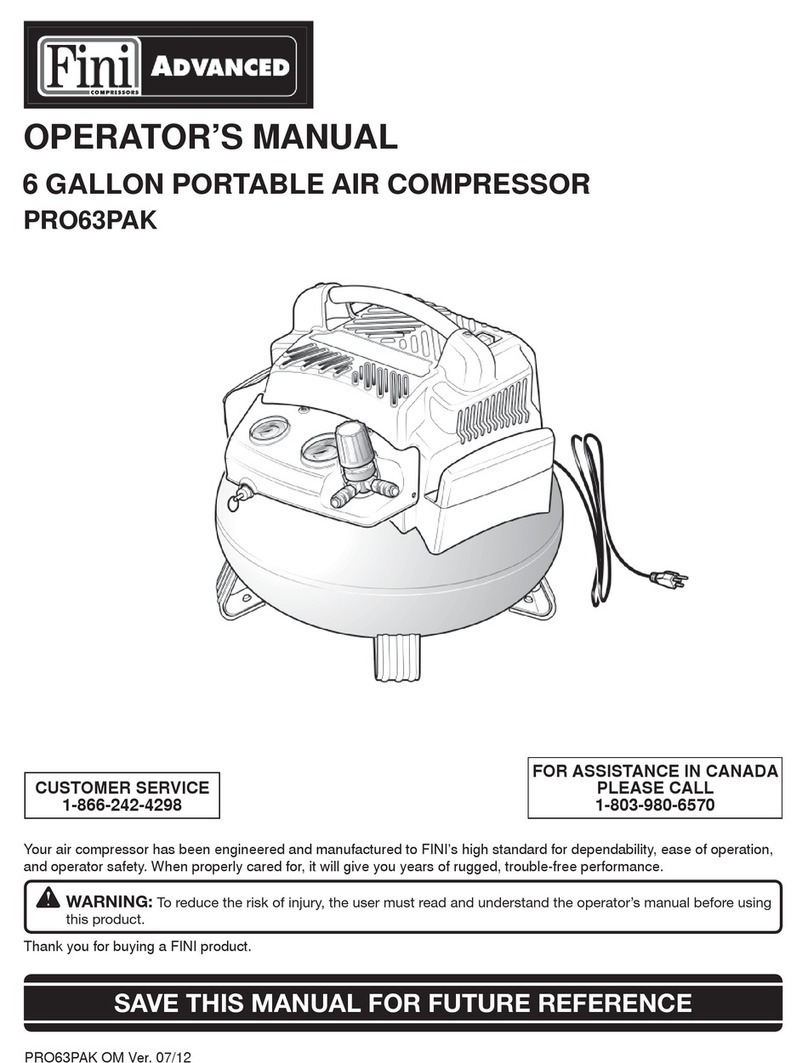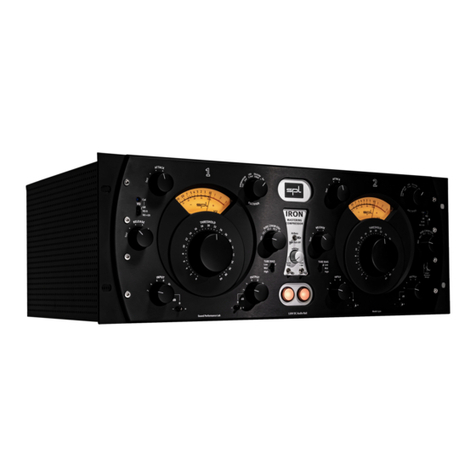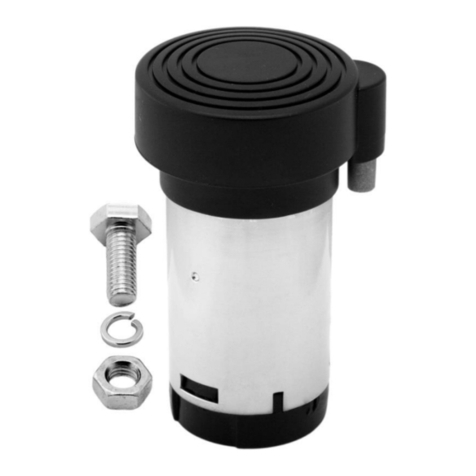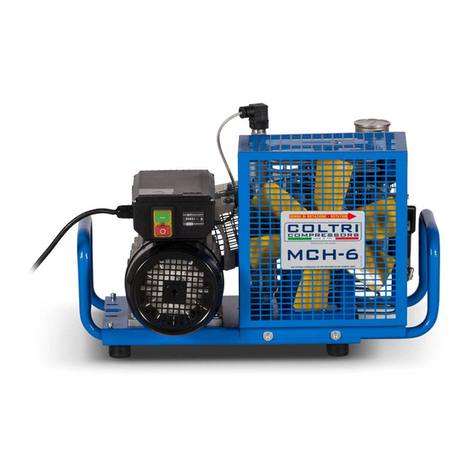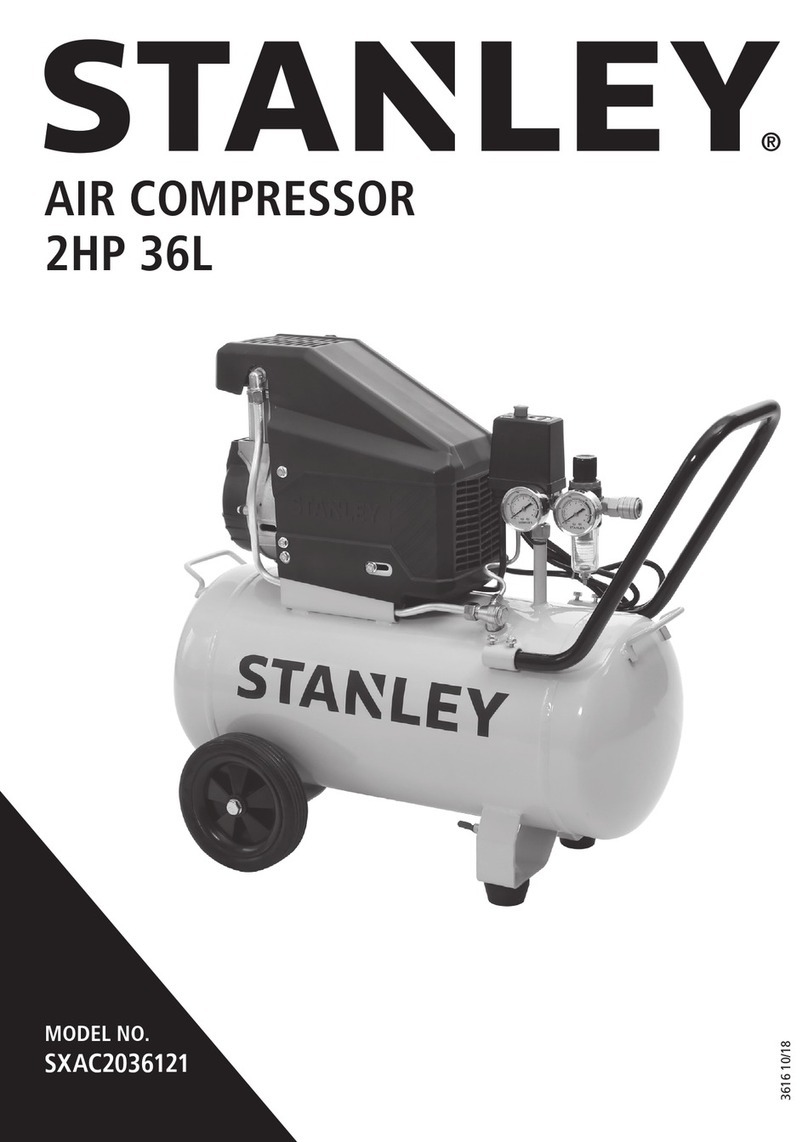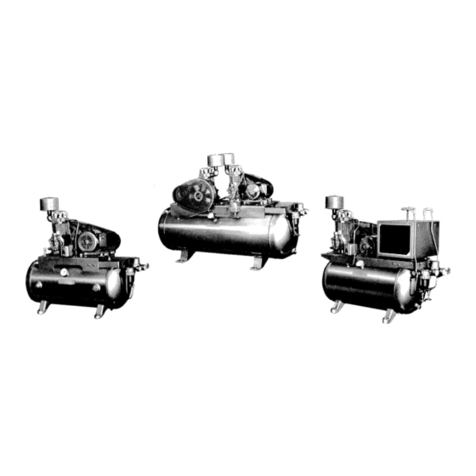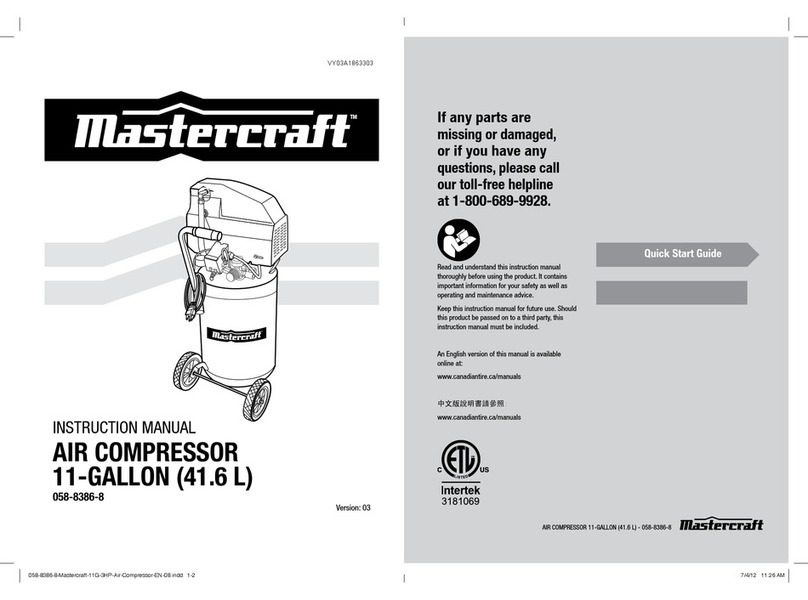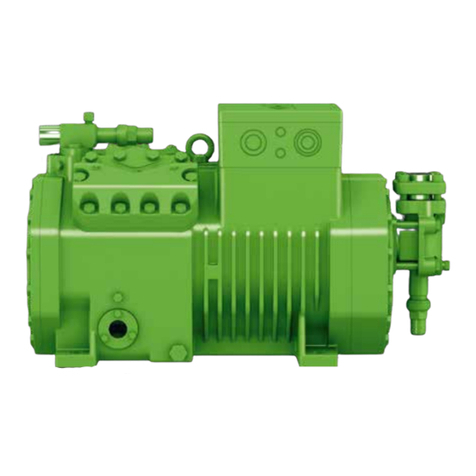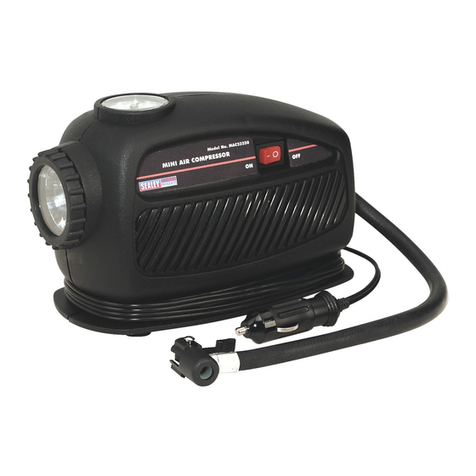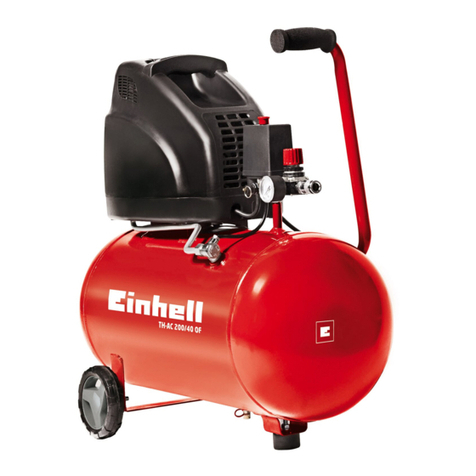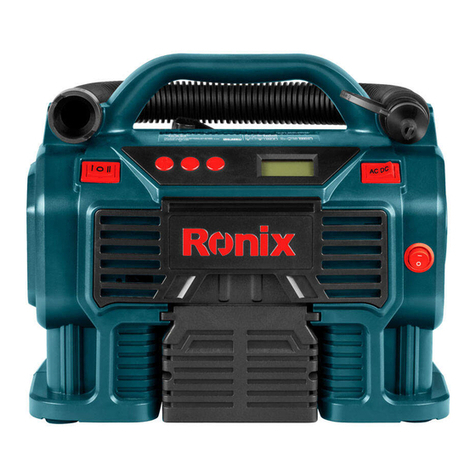HARDER & STEENBECK 20A User manual

Bedienungsanleitung
Operating Instructions
Mode d’emploi
Instrucciones de uso
Instrucciones per l’uso
Bruksanvisning
Kompressoren
20A, 25A, 30A,
50A, 100A

2
Inhaltsverzeichnis
Bedienungsanleitung . . . . . . . . . . . . . . . . . . . . . . . . . . . . . . . . . 3 - 10
Operating Instructions . . . . . . . . . . . . . . . . . . . . . . . . . . . . . . . . 11 - 18
Mode d'emploi. . . . . . . . . . . . . . . . . . . . . . . . . . . . . . . . . . . . . . . 19 - 26
Instrucciones de uso. . . . . . . . . . . . . . . . . . . . . . . . . . . . . . . . . . 27 - 34
Istruzioni per l'uso. . . . . . . . . . . . . . . . . . . . . . . . . . . . . . . . . . . . 35 - 42
Bruksanvisning . . . . . . . . . . . . . . . . . . . . . . . . . . . . . . . . . . . . . . 43 - 50
Abbildungen, Illustrations, Illustrations,
Figuras, Figure, Bilder . . . . . . . . . . . . . . . . . . . . . . . . . . . . . . . . 51 - 52
Teilebezeichnung, part designation,
Nomenclature, Denominación,
Definizione, Delbeteckning. . . . . . . . . . . . . . . . . . . . . . . . . . . . . 53 - 59
D
GB
F
E
I
S

3
D
Einleitung
Vorwort
Diese Bedienungsanleitung gilt für die Kompressoren der Typenreihen 20A, 25A, 30A, 50A und 100A.
Sie enthält wichtige Hinweise, wie Sie Ihren Kompressor sicher, sachgerecht und wirtschaftlich betrei-
ben können.
Wichtige Sicherheitshinweise
Bitte lesen Sie vor der Inbetriebnahme die Bedienungsanleitung sorgfältig durch und beachten Sie die
angeführten Hinweise!
Achtung: Eine sofortige Inbetriebnahme beschädigt den Kompressor und kann zur Zerstö-
rung des Motors führen.
Prüfen Sie, ob keine Transportschäden vorhanden sind. Der Schalter muss sich vor Inbetriebnahme
in Off- bzw. 0-Stellung befinden. Sollte das Gerät Mängel aufweisen, wenden Sie sich bitte umgehend
an Ihren Verkäufer. Bewahren Sie den Verpackungskarton für eine eventuelle Garantie-Reparatur auf.
Die Geräte werden vom Hersteller nur in der Originalverpackung und mit Rücksendung auf Palette
akzeptiert.
Der Kompressor unterliegt strengen Sicherheitsnormen und wird vom Hersteller beim Verlassen der
Produktionsstätte auf dessen Funktionsfähigkeit streng überprüft. Beachten Sie deshalb die folgen-
den Vorschriften.
Lassen Sie das Gerät nur durch einen Fachhändler reparieren.
Setzen Sie das Gerät niemals mit nassen oder bloßen Füßen in Betrieb und berühren Sie es nicht mit
nassen Händen.
Ziehen Sie nicht am Netzkabel, sondern schalten Sie den Kompressor immer am Druckschalter ein
und aus.
Lassen Sie den laufenden Kompressor niemals unbeaufsichtigt.
Kindern ist der Gebrauch des Gerätes untersagt.
Schützen Sie den Kompressor vor Kälte.
Eine den Sicherheitsnormen entsprechende Erdung gewährleistet die elektrische Sicherheit des
Gerätes. Sollte die vorschriftsmäßige Erdung nicht vorhanden sein, übernimmt der Hersteller für even-
tuelle Schäden bzw. Unfälle keine Haftung.
Das Gerät ist für die landesübliche Betriebsspannung ausgelegt und darf ausschließlich an einer ord-
nungsgemäß installierten und abgesicherten Steckdose betrieben werden. Die Spannung muss der
auf dem Etikett der technischen Daten angegebenen Spannung entsprechen.
Die Steckdose, an der das Gerät betrieben wird, muss gut zugänglich sein, damit das Gerät bei Bedarf
jederzeit schnell von der Stromversorgung getrennt werden kann.
Sicherheits- und Schutzeinrichtungen des Gerätes dürfen nicht verändert oder funktionslos gemacht
werden.
Sollten beim Betrieb des Gerätes unübliche Geräusche, Gerüche oder Störungen auftreten, ist das
Gerät sofort vom Netz zu trennen. Bei Bedarf ist eine Fachwerkstatt heranzuziehen. Erst wenn das
Gerät wieder in ordnungsgemäßem Zustand ist, darf es wieder in Betrieb genommen werden.
Achten Sie darauf, dass der Kompressor sich in einem gut durchlüfteten Raum befindet und das
Lüfterrad freie Luftzufuhr hat.
Der Verdichter darf niemals Regen oder Wasserstrahlen ausgesetzt werden.
Bei Versprühen von brennbaren Flüssigkeiten besteht Feuer- und/oder Explosionsgefahr.
Den Kompressor nicht in der Nähe von Feuer benutzen. Berühren Sie weder den Zylinderkopf, noch
die Kühlrippen oder die Druckleitung, da sie sehr hohe Temperaturen erreichen können.
Keine leicht entflammbaren Gegenstände, Stoffe oder Nylon in die Nähe des Kompressors bringen.
Den Kompressor nicht verwenden, wenn das Netzkabel beschädigt ist, bzw. der Stromanschluss den
Sicherheitsnormen nicht entspricht.
Der Druckstrahl darf niemals auf Personen oder Tiere gerichtet werden.
Tragen Sie dafür Sorge, dass andere den Kompressor nur nach Erhalt der erforderlichen Anweisung
benutzen.

4D
Hinweise zum Umweltschutz
Das Symbol auf dem Produkt, der Bedienungsanleitung oder der Verpackung weist darauf
hin, dass dieses Produkt am Ende seiner Lebensdauer nicht über den normalen
Haushaltsabfall entsorgt werden darf. Es muss an einem Sammelpunkt für das Recycling
von elektrischen und elektronischen Geräten abgegeben werden.
Die Werkstoffe sind gemäß ihrer Kennzeichnung wieder verwertbar. Mit der Wiederverwendung, der
stofflichen Verwertung oder anderen Formen der Verwertung von Altgeräten leisten Sie einen wichti-
gen Beitrag zum Umweltschutz.
Beachten Sie im eigenen Interesse folgende Punkte:
Lesen Sie die Bedienungsanleitung vor der Inbetriebnahme sowie vor der Durchführung von War-
tungsarbeiten.
Nur die Einhaltung der Bedienungsanleitung gilt als bestimmungsgemäße Verwendung.
Die Bedienungsanleitung ist ständig in unmittelbarer Nähe des Kompressors aufzubewahren.
Bestimmungsgemäße Verwendung:
Dieser Kompressor wurde zum Betrieb von handelsüblichen Airbrush-Apparaten konstruiert.
Beachten Sie auch folgendes:
Zur bestimmungsgemäßen Verwendung gehört auch die Durchführung der in dieser Bedienungs-
anleitung beschriebenen Wartungsarbeiten sowie die ordnungsgemäße Entsorgung verwendeter
Betriebsmittel.
Jeder anderweitige Gebrauch, als der in dieser Bedienungsanleitung beschriebenen, gilt als nicht
bestimmungsgemäß. Konsequenzen hieraus trägt allein der Betreiber.
Es ist nicht zulässig, den Kompressor konstruktiv zu verändern.
Warnhinweise
In dieser Bedienungsanleitung werden Ihnen immer wieder bestimmte Warnhinweise und
Absatzformate begegnen. Diese haben folgende Bedeutung:
Achtung: Dieses Symbol weist auf eine Gefahr für Mensch und/oder Maschine hin.
Beachten Sie diese Sicherheitshinweise im eigenen Interesse.
Hinweis: Dieses Symbol bezeichnet Anwendungs-Tipps und andere nützliche Informatio-
nen.
Hinweis: Dieses Symbol taucht immer dann auf, wenn es um Betriebsstoffe oder Mate-
rialien geht, die zum Schutz der Umwelt gesetzeskonform behandelt und ent-
sorgt werden müssen.
1. Mit einer vorgestellten Ziffer werden Arbeitsschritte gekennzeichnet, die in der vor-
gegebenen Reihenfolge abzuarbeiten sind.
Transporthinweise
Möchten Sie das Gerät, nachdem es bereits in Betrieb genommen wurde transportieren, ersetzen Sie
den (die) Luftfilter durch die Abdeckkappe(n). Achten Sie darauf, dass der Kompressor gegebenen-
falls nur aufrecht auf Palette transportiert werden darf.
Der Hersteller haftet nicht für Schäden, die durch den Transport entstehen.

5
D
Gewährleistung
Der Hersteller übernimmt für dieses Produkt gegenüber dem original Käufer für einen Zeitraum von
zwei Jahren ab Kaufdatum die Gewährleistung dafür, dass das Produkt zum Zeitpunkt der Lieferung
frei von Sachmängeln war. Während der Gewährleistungszeit wird das Produkt bei Vorliegen eines
Sachmangels nach Vorlage des Kaufbelegs innerhalb eines vernünftigen Zeitrahmens repariert oder
durch ein gleiches oder ein Ersatzmodell ersetzt.
Bei gewerblicher Nutzung des Produktes beträgt die Gewährleistung zwölf Monate ab Kaufdatum.
Weder diese Gewährleistung noch irgendeine andere Gewährleistung oder Garantie, entweder aus-
drücklich zugesagt oder anderweitig vorgeschrieben, einschließlich einer Gewährleistung oder einer
Bedingung hinsichtlich der handelsüblichen Qualität oder Eignung für einen bestimmten Zweck,
haben über die hier angegebene Gewährleistungszeit hinaus Gültigkeit.
Vor der Erstinbetriebnahme
Gerät auspacken
Nachdem Sie den Kompressor ausgepackt haben, kontrollieren Sie das Gerät auf eventuelle Trans-
portschäden. Entfernen Sie die Kartonstreifen, die bei einigen Modellen als Transportsicherung dienen.
Hinweis: Möchten Sie das Gerät später wieder transportieren, ist es sinnvoll, das Verpa-
ckungsmaterial aufzubewahren und dann wieder zu verwenden. Auch die Abdeck-
Kappe sollte für einen Weitertransport wieder verwendet werden.
Hinweis: Sollten Sie das Verpackungsmaterial nicht mehr benötigen, ist es gemäß den gel-
tenden Bestimmungen zu entsorgen.
Gerät auf Vollständigkeit prüfen
Prüfen Sie, ob das Gerät vollständig geliefert wurde. Der Lieferumfang umfasst, neben dem Kompres-
sor, folgende Teile:
Eine Flasche Öl plus eine Einfüllspitze zum Aufschrauben auf die Ölflasche (bei allen 20A, 25A und
30A-Modellen). Bei den 50A und 100 A-Modellen ist das Öl bereits eingefüllt.
Ein Luftfilter (bei Modell 100A zwei Luftfilter)
Ein Plastikschlauch zum Einfüllen des Öls (Modelle EURO-TEC 20A, 30A und HTC 20A). Ein Plastik-
schlauch zum Ablassen des Kondensats aus dem Tank (Modelle HTC 30A, HTC und EURO-TEC 50A)
Gerät aufstellen
Stellen Sie den Kompressor in einem gut belüfteten, ausreichend großen Raum auf eine ebene
Fläche.
Die Raumtemperatur sollte nicht höher als 35°C sein.
Verfügt der Raum nicht über eine ausreichende Frischluftzufuhr, ist für eine ausreichende Frischluft-
zufuhr zu sorgen.
Inbetriebnahme
Achtung: Vor der Erstinbetriebnahme muss geprüft werden, ob der Kompressor mit Öl gefüllt
ist.
1. Prüfen Sie am Ölschauglas, ob der Kompressor mit Öl gefüllt ist.
Achtung: Ist der Kompressor nicht oder nur unzureichend mit Öl gefüllt, gehen Sie vor wie
unter „Öl einfüllen“.
Ist der Kompressor ausreichend mit Öl gefüllt, gehen Sie vor wie nach Punkt 7 unter
“Öl einfüllen”
Achtung: Um die Lebensdauer und den Betrieb des Kompressors nicht zu beeinträchtigen,
muss die Ein-/Ausschaltdauer von 15 Min. ein/15 Min. aus unbedingt eingehalten
werden. Eine längere Einschaltdauer bewirkt die Überhitzung und einen erhöhten

6D
Ölverbrauch des Kompressors mit negativen Auswirkungen auf dessen Leistungs-
fähigkeit.
Hinweis: Unsere Kompressoren werden werksseitig mit Schnellkupplung(en) NW 5,0 mm
ausgeliefert. Zum Anschluss eines Luftschlauches empfehlen wir einen Stecknippel
NW 5,0 mm
Öl einfüllen EURO-TEC 20A, 30A und Aero-pro HTC 20A, 25A und 30A Modelle (Fotos Seite 52)
Achtung: Verwenden Sie ausschließlich das original Kompressoren Öl SINCOM/32E
(Art. Nr. 132010)
1. Entfernen Sie den Plastikschlauch aus dem Einfüllstutzen (abhängig vom verwen
deten Modell). Beachten Sie bitte auch das ggf. beiliegende rote DIN-A4 Blatt. (Abb. 1)
2. Schrauben Sie die mitgelieferte Einfüllspitze auf die geöffnete Ölflasche und
schneiden Sie die Spitze ab. Stecken Sie den mitgelieferten transparenten Plastik-
schlauch auf die Einfüllspitze.
3. Entfernen Sie die Abdeckkappe von dem Ansaugstutzen. (Abb. 3)
4. Füllen Sie das Öl ein, indem Sie die Ölflasche mit dem transparenten Schlauch in
den Einfüllstutzen stecken. (Abb. 4)
5. Prüfen Sie den Ölstand am Ölschauglas nachdem ca. 2/3 des Flascheninhaltes
eingefüllt wurde. (Abb. 5)
6. Sollte der korrekte Ölstand noch nicht erreicht sein, wiederholen Sie den Vorgang.
7. Nachdem Sie den Auffüllvorgang beendet haben, stecken Sie den schwarzen
Plastikschlauch wieder in den Einfüllstutzen. (Abb. 7)
Achtung: Der Ölstand darf nicht über dem maximalen Stand liegen. Sollte das der Fall sein,
müssen Sie überschüssiges Öl wieder ablassen, siehe „Öl ablassen“.
Verwenden Sie zum Nachfüllen ausschließlich das Original Kompressoren-Öl, da
sonst die Garantie erlischt.
Hinweis: Bewahren Sie das verbleibende Öl zum späteren Nachfüllen auf.
8. Stecken den mitgelieferten Luftfilter auf den Ansaugstutzen. (Abb. 8) bzw. in die
Motordeckelöffnung (abhängig vom verwendeten Modell)
9. Verbinden Sie erst jetzt das Gerät mit einer geeigneten Stromquelle und schalten
Sie den Kompressor durch Drehen des Ein-/Ausschalters auf Stellung I ("Ein") ein.
Der Kompressor ist jetzt betriebsbereit und muss in seiner horizontalen Lage bleiben. Wird das Gerät
schräg gestellt, kann Öl in die Kompressionskammern gelangen und diese schädigen.
Öl ablassen (siehe Abb. 2, Seite 51)
Haben Sie versehentlich zu viel Öl eingefüllt, müssen Sie Öl ablassen.
1. Wenn notwendig, Motor vom Tank demontieren.
2. Motordeckel abnehmen; hierzu die Schelle für Motordeckel lösen.
3. Motoraggregat neigen (auf keinen Fall abrupt auf den Kopf stellen) und mit der
freien Hand den Motorblock festhalten)
4. Gehäuse nur soweit neigen, dass das Öl abfließt.
5. Zustand des O-Rings am Motorgehäusedeckel kontrollieren.
6. Deckel auf das Gehäuse aufsetzen und dabei darauf achten, dass der O-Ring
richtig sitzt um eine 100-%ige Dichtung zu gewährleisten.
7. Die Schelle für Motordeckel wieder montieren.
8. Motoraggregat wieder auf den Tank aufsetzen und befestigen.

7
D
Kompressor einschalten
Der Motor baut nun Druck auf und ist, abhängig vom Kompressortyp, nach 40 bis 240 Sekunden
betriebsbereit.
Der Kompressor ist mit einer Automatik ausgestattet. Nachdem der Motor den maximalen Druck auf-
gebaut hat, schaltet diese Automatik den Motor selbstständig ab.
Bei einer Luftentnahme aus dem Drucktank wird der Motor bei Erreichen eines Drucks von vier bzw.
sechs bar wieder automatisch eingeschaltet.
Achtung: Sämtliche Kompressoren sind mit einem Sicherheitsventil ausgestattet. Dieses
darf weder entfernt, noch verändert werden. Eine Reparatur bzw. Austausch des
Sicherheitsventils darf ausschließlich durch eine qualifizierte Fachwerkstatt vorge-
nommen werden.
Arbeitsdruck einstellen (siehe Abb. 6, Seite 52)
Der gewünschte Arbeitsdruck kann am Druckregler eingestellt werden. Die Anzeige des Arbeitsdrucks
erfolgt am Manometer
1. Ziehen Sie den Drehknopf nach oben.
2. Druck erhöhen: Drehen Sie den Drehknopf im Uhrzeigersinn.
Druck vermindern: Drehen Sie den Drehknopf gegen den Uhrzeigersinn.
3. Nachdem Sie den gewünschten Arbeitsdruck eingestellt haben, drücken Sie den
Drehknopf wieder nach unten.
Umgang mit dem Motorschutzschalter
Sämtliche Kompressoren sind mit einem Motorschutzschalter ausgestattet. Dieser schaltet den Motor
bei Überlastung oder Überhitzung selbstständig ab, um das Gerät vor Beschädigung zu schützen.
Falls sich der Kompressor während des normalen Betriebs ausschaltet, gehen Sie wie folgt vor:
1. Drehen Sie den Ein-/Aus-Schalter auf 0 („Aus“) und lassen das Gerät ca. 30 Minu-
ten abkühlen.
2. Nach ca. 30 Minuten können Sie das Gerät wieder einschalten.
3. Monatliche Wartungsarbeit durchführen.
Kompressor ausschalten
Bei längerer Nichtnutzung des Kompressors ist das Gerät auszuschalten.
Achtung: Das Gerät ist auch auszuschalten, wenn es scheinbar außer Betrieb ist, der Motor
also nicht läuft. Das ist dann der Fall, wenn der Motor maximalen Druck aufgebaut
und die Automatik geschaltet hat. Der Motor befindet sich in einem „Stand-by-
Modus“ und springt sofort wieder an, wenn der Druck unter einen bestimmten
Wert fällt.
Um das Gerät auszuschalten, drehen Sie den Ein-/Aus-Schalter in Stellung 0 („Aus“).

8D
Wartungsarbeiten
Um die Lebensdauer Ihres Kompressors zu erhöhen, sollten Sie die nachfolgenden Wartungsarbeiten
in den empfohlenen Intervallen durchführen.
Achtung: Vor dem Beginn von Wartungsarbeiten ist das Gerät von der Stromversorgung zu
trennen.
Wöchentlich
Ölstand prüfen
Kontrollieren Sie einmal wöchentlich bei abgeschaltetem Kompressor den Ölstand am Ölschauglas,
und füllen Sie bei Bedarf die erforderliche Ölmenge nach, siehe „Öl einfüllen“.
Monatlich
Sichtkontrollen durchführen
Führen Sie einmal im Monat eine Sichtkontrolle des Gerätes durch. Achten Sie dabei besonders auf
eventuell gelockerte Anschlüsse und Schrauben sowie auf den allgemeinen Zustand der Druck-
schläuche.
Kondenswasser aus dem Tank ablassen (siehe Seite 51, Abb. 3)
Hinweis: Austretendes Kondensat ist mit geeigneten Mitteln, beispielsweise einem Lappen,
aufzufangen.
Lassen Sie einmal im Monat das Kondenswasser mit der Ablassschraube aus dem Tank ab. Dabei
muss der Tank unter Druck stehen.
Öffnen Sie dazu einmal kurz den Ablasshahn. Abhängig vom verwendeten Typ, ist dieser ober- oder
unterhalb des Tanks angebracht. Bei oben liegendem Ablasshahn ist das mitgelieferte Röhrchen zum
Ablassen des Kondensats zu verwenden.
Wasser aus dem Wasserabscheider ablassen (siehe Seite 51, Abb. 4)
Hinweis: Austretendes Kondensat ist mit geeigneten Mitteln, beispielsweise einem Lappen,
aufzufangen.
Einmal monatlich (bei Bedarf öfter) sollten Sie das Kondenswasser aus dem Wasserabscheider ablas-
sen.
Drehen Sie dazu den Drehknopf im Uhrzeigersinn, drücken ihn ein, halten ihn gedrückt, bis das
Wasser herausgelaufen ist. Nach dem Ablassen des Kondenswassers drehen Sie den Drehknopf
gegen den Uhrzeigersinn. Der Tank muss dabei unter Druck stehen.
Viertel- oder Halbjährlich
Filter ausbauen (siehe Seite 51, Abb. 5)
Filter säubern in einem geeigneten Reiniger (z.B. Geschirrspülmittel), dazu Filter ausbauen.

Störungstabelle
Achtung: Bei Störungen ist das Gerät unverzüglich stromlos zu machen.
Reparaturen dürfen ausschließlich von ausgebildetem und qualifiziertem Fach-
personal durchgeführt werden.
Störungen Mögliche Ursachen Abhilfe
Der Motor des Kompressors Kein Strom Sicherung und Stecker prüfen
springt nicht an
Kabelbruch oder lose Fachwerkstatt
elektrische Verbindungen
Ölstand zu hoch Öl ablassen
Druck im Tank zu hoch, Luft aus dem Tank ablassen
Druckschalter hat abgeschaltet
Kompressor arbeitet, Abdeckkappe ist nicht vom Abdeckkappe entfernen
baut aber keinen Druck auf Ansaugrohr entfernt
Luftfilter ist verschmutzt Luftfilter auswechseln
Anlage ist undicht Schlauch- und Steckverbindun-
gen auf Undichtigkeit prüfen
Kompressor arbeitet, Anlage ist undicht Schlauch- und Steckverbindun-
erreicht aber nicht den gen auf Undichtigkeit prüfen
maximalen Druck
Einstellung des Druckschalters Einstellung prüfen, ggf. an Fach-
nicht in Ordnung werkstatt wenden
Rückschlagventil ist defekt Rückschlagventil auswechseln
oder verstopft
Kompressor schaltet Motor ist zu heiß, Motorschutz- Kompressor ausschalten,
während des Betriebes ab schalter hat abgeschaltet Motor abkühlen lassen
Gerät wurde zu stark beansprucht
Kompressor läuft, Anlage ist undicht Schlauch- und Steckverbindun-
ohne dass gearbeitet wird gen auf Undichtigkeit prüfen
Kompressor schaltet nicht ein, Druckschalter defekt Druckschalter durch eine Fach-
wenn Druck unter Minimum werkstatt auswechseln lassen
steht bzw. schaltet bei
max. Druck nicht ab
9
D

10 D
Störungen Mögliche Ursachen Abhilfe
Kompressor wird zu heiß Ölstand nicht in Ordnung Ölstand prüfen, ggf. Öl nachfüllen
Falsche Ölsorte Öl ablassen und durch Kompres-
soröl ersetzen
Luftfilter ist verschmutzt Luftfilter wechseln
Raumtemperatur ist zu hoch Für ausreichende Luftzufuhr
oder Luftzufuhr ist nicht sorgen
ausreichend
Kompressor wird zu stark Prüfen, ob Kompressor
beansprucht den Ansprüchen genügt
Hinweis: Die hier aufgeführten Möglichkeiten eventueller Störungsursachen erheben kei-
nen Anspruch auf Vollständigkeit.
Technische Daten
Nachfolgend erhalten Sie eine Tabelle mit den Leistungswerten (gem. Hersteller) der einzelnen
Kompressor-Typen.
Modell Spannung Leistung Ansaug- Druck Tank- Laut- Gewicht
leistung inhalt stärke netto
Volt Watt Liter bar Liter dB (A) 1m kg
20A 230/50 135 17 6 1,5 38 18
25A 230/50 135 17 6 3,5 38 16
HTC 30A 230/50 200 25 8 9 40 19
30A 230/50 200 25 8 4 40 19
HTC 50A 230/50 340 50 8 15 43 26
50A 230/50 340 50 8 24 43 29
100A 230/50 680 100 8 24 43 48
Änderungen und Irrtum vorbehalten.

11
GB
Introduction
Preface
This operating manual applies to type 20A, 25A, 30A, 50A and 100A series compressors. It contains
important information on the safe, correct and economical operation of your compressor.
Important safety instructions
Please read the operating manual carefully prior to commissioning and observe the instructions con-
tained therein!
Warning: immediate commissioning will damage the compressor and can lead to the destruc-
tion of the motor.
Check for transportation damage. The switch should be in the Off (or 0) position prior to commissio-
ning. Please contact the retailer immediately should deficiencies be detected on the unit. Retain the
packaging carton in case guarantee repairs should prove necessary. Units will only be accepted by the
manufacturer in their original packaging and retoure on pallet.
The compressor is subject to strict safety standards and its functionality has been thoroughly inspec-
ted and tested by the manufacturer at the time of leaving the factory. Please heed the following
instructions in this respect.
The unit should only be entrusted to a specialised dealer for repairs.
Never operate the unit with wet or bare feet and do not touch it with wet hands.
Do not tug on the power cable. The compressor should be activated and deactivated in every case
using the push button.
Never leave the compressor running unsupervised.
Children should never be allowed to use the unit.
Protect the compressor against the effects of cold.
Earthing in compliance with safety standards will ensure the electrical safety of the unit. The manu-
facturer bears no liability for any subsequent damage, injury or accidents occurring in the absence of
correct earthing.
The unit is designed for standard national voltage and should only be connected to a correctly instal-
led and earthed electrical socket. Voltage should correspond to the voltage specified on the techni-
cal data label.
The socket to which the unit is connected should be easily accessible to allow speedy disconnection
from the power supply at all times should the need arise.
Unit safety and protective equipment should not be altered or deactivated.
The unit should be disconnected immediately from the mains power supply if unusual noises, odours
or malfunctions are detected during operation. A specialised workshop should be contacted if neces-
sary. The machine should only be used when it is in a perfect operating condition again.
Ensure that the compressor is located in a well-ventilated room and that the air impeller receives an
unhindered supply of air.
The compressor should never be exposed to rain or water spray.
There is a risk of fire and/or explosion if the unit is sprayed with flammable liquids.
Do not use the compressor near exposed fires. Never touch the cylinder head, cooling ribs or pressu-
re line, as these can reach extremely high temperatures.
Keep highly-flammable objects, materials or nylon away from the compressor.
Do not use the compressor if the power cable is damaged or the electrical power connection does not
comply with safety standards.
Never direct the pressure blast towards people or animals.
Ensure that other persons are only permitted to use the compressor after receiving the necessary
instruction.

Environmental protection instructions
The symbol on the product, operating manual or the packaging indicates that this product
should not be disposed of in normal household waste at the end of its service life. It should
be brought to a collecting point for the recycling of electrical and electronic devices.
Materials should be recycled according to their respective markings. Recycling of old devices
or the recycling or other re-use of materials contained therein represents an important contribution to
environmental protection.
Please heed the following instructions in your own interest:
Read the operating manual prior to commissioning and before realising maintenance work.
Only adherence to the operating manual is regarded as correct use.
The operating manual should be kept immediately next to the compressor at all times.
Correct use:
This compressor was designed to operate commercially-available airbrush devices.
Please also heed the following:
Correct use also includes the realisation of maintenance work described in this operating manual and
correct disposal of operational media utilised.
Any use other than that described in this operating manual is regarded as incorrect. The operator is
solely responsible for the consequences of such incorrect use.
Design and constructional changes to the compressor are prohibited.
Warning instructions
You will repeatedly encounter certain warning instructions and paragraph formats in this operating
manual. These have the following meaning:
Warning: This symbol indicates a hazard for people and/or the machine.
Always heed these safety instructions in your own interest.
Note: This symbol indicates user tips and other useful information.
Note: This symbol appears repeatedly where operating media or
materials are involved that must be handled and disposed of in accordance with
legal directions for environmental protection.
1. Numbered instructions indicate working steps that should be
realised in the sequence specified.
Transportation instructions
Replace the air filter(s) with the covering cap(s) if you wish to transport the unit after it has already
been in use. Ensure that the compressor is only transported in an upright position on a pallet.
The manufacturer bears no liability for damage caused through transportation.
12 GB

13
GB
Warranty
The manufacturer guarantees the original purchaser that the product was free from material defects
at the time of delivery, said warranty applying to this product for a period of two years from the pur-
chase date. In the event of the product exhibiting a material defect during the warranty period, the
product shall, where a purchase receipt is produced, be repaired within a reasonable period of time
or replaced with an equivalent or replacement model.
The warranty period is twelve months from the purchase date in the case of commercial use of the
product.
Neither this warranty or any other warranty or guarantee, either expressly assured or otherwise spe-
cified, including a warranty or a condition with regard to commercial quality or suitability for a parti-
cular purpose, has validity beyond the warranty period stipulated.
Prior to initial commissioning
Unpacking the unit
Check the unit for any transportation damage after unpacking the compressor. Remove the cardbo-
ard strips used as transportation securing elements with some models.
Note: It is sensible to retain packaging materials for future use should you wish to
transport the unit again at a later date. The covering cap should also be retained for
future transportation purposes.
Note: Packaging material should be disposed of in accordance with valid regulations
if it is no longer required.
Checking the integrity of the unit
Check to ensure that the unit has been delivered in its entirety. In addition to the compressor, the
scope of delivery encompasses the following components:
A bottle of oil and a filling nozzle for screw fitting to the oil bottle (for all 20A, 25A and 30A models).
The oil is already filled in the case of 50A and 100 A models.
An air filter (two air filters in the case of the 100A model)
A plastic hose for filling the oil (Euro-Tec 20A, 30A and HTC 20A models).
A plastic hose for expelling condensate from the tank (HTC 30A, HTC and EURO-TEC 50A models)
Unit installation and set-up
Install the compressor on a level surface in a well-ventilated room with adequate space.
Room temperature should not exceed 35°C.
An adequate supply of fresh air should be established where the room does not receive a sufficient
supply of air.
Commissioning
Warning: the unit should be inspected prior to commissioning to ascertain whether it is filled
with oil.
1. Check the oil inspection glass to ascertain whether the compressor is filled with
oil.
Warning: in the event of the compressor containing no oil or inadequate oil, proceed as des
cribed in "Filling oil".
Where the compressor has been adequately filled with oil, proceed as described in
Item 7 in "Filling oil"
Warning: it is imperative that the activation/deactivation duration of 15 min. on/15 min. off
be observed to avoid impairing the service life and operation of the compressor.
A longer activation duration causes overheating and increased oil consumption by
the compressor with negative effects on its performance.

14 GB
Note: our compressors are fitted by us with one or more quick-action couplings (nom. dia-
meter 5.0 mm). We recommend use of a plug-in nipple (nom. diameter 5.0 mm) for
connecting an air hose.
Fill oil for EURO-TEC 20A, 30A and Aero-pro HTC 20A, 25A and 30A models (photos on Page 52).
Warning: use only original SINCOM/32E compressor oil (Art. No. 132010).
1. Remove the plastic hose from the filling tube (depending on the model used).
Please also heed the red DIN A4 sheet if it is included in the delivery (Fig. 1).
2. Screw the filling nozzle provided onto the open oil bottle and cut the tip off the
nozzle. Push the transparent plastic hose provided onto the filling nozzle.
3. Remove the covering cap from the filling spout (Fig. 3).
4. Fill the oil by inserting the oil bottle with the transparent hose into the filling tube
(Fig. 4).
5. Check the oil level in the inspection glass after approx. 2/3 of the bottle contents
have been filled (Fig. 5).
6. Repeat the procedure if the correct oil level has not been reached.
7. On completion of oil filling, push the black plastic hose provided onto the filling tube
again (Fig. 7).
Warning: the oil level should not exceed the maximum indicated. Excess oil should be drained
where the oil level is exceeded (see "Draining oil").
Use only original compressor oil to fill the unit, as a failure to do so will render the
guarantee null and void.
Note: retain the remaining oil for future filling operations.
8. Push the air filter provided onto the filling spout (Fig. 8) or into the motor hood ope-
ning (depending on the model used).
9. The unit should only now be connected to a suitable electrical power supply. Activate
the compressor by turning the on/off switch to position I ("ON").
The compressor is now ready for operation and should remain in a horizontal position. Oil can pene-
trate the compression chambers and damage these if the unit is tilted.
Drain the oil (see Fig. 2, Page 51).
If the compressor is filled with too much oil the oil should be drained.
1. Remove the motor from the tank if necessary.
2. Remove the motor hood. Loosen the motor hood clamp for this purpose.
3. Tilt the motor unit (but never upend it abruptly) and hold the motor block firmly with
your free hand.
4. Only tilt the housing far enough to allow the oil to flow out.
5. Check the condition of the O-ring on the motor housing hood.
6. Place the hood on the housing, ensuring that the O-ring is positioned correctly to
guarantee a 100% seal.
7. Fit the clamp on the motor hood again.
8. Mount the motor unit on the tank again and secure in position.

15
GB
Activating the compressor
The motor builds up the required pressure and is ready for operation after 40 to 240 seconds (depen-
ding on the compressor type).
The compressor is fitted with an automatic shut-off switch. The shut-off switch automatically deacti-
vates the motor after it has built up the maximum pressure required.
The motor is automatically reactivated when the pressure reaches four to six bar in the event of air
being removed from the pressure tank.
Warning: All compressors are fitted with a safety valve. This should not be removed or alte-
red. Repair or replacement of the safety valve should be entrusted to a qualified
specialist workshop.
Setting the working pressure (see Fig. 6, Page 52)
The desired working pressure can be set with the pressure regulator. The working pressure is indica-
ted on a pressure gauge
1. Pull the knob upwards.
2. Increasing the pressure: Turn the knob in a clockwise direction.
Reducing the pressure: Turn the knob in an anticlockwise direction.
3. Push the knob downwards again after the desired working pressure has been set.
Motor circuit breaker switch
All compressors are fitted with a motor circuit breaker. This automatically deactivates the motor in the
event of overloading or overheating to protect the unit against damage.
Proceed as follows in the event of the compressor being switched off during normal operation:
1. Turn the on/off switch to 0 ("OFF") and allow the unit to cool for approx. 30 minutes.
2. The unit can be switched on again after approx. 30 minutes.
Deactivating the compressor
The unit should be deactivated if the compressor is not used for a longer period of time.
Warning: The unit should be deactivated if it appears not to be operating (i.e. the motor is not
running). This is the case if the motor has built up the required maximum pressure
and the automatic shut-off switch has been triggered. The motor is in standby mode
and activates immediately again if the pressure drops below a particular value.
Turn the on/off switch to the 0 position ("OFF") to deactivate the unit.
Maintenance work
The following maintenance work should be realised at the recommended intervals to increase the ser-
vice life of your compressor.
Warning: The unit should be disconnected from the electrical power supply prior to commen-
cing maintenance work.
Weekly
Check the oil level
Check the oil level in the oil inspection glass once a week while the compressor is switched off and
top up with the required volume of oil if necessary (see "Filling oil").

Monthly
Carry out visual inspection
Carry out a visual inspection of the unit once a month. Ensure in particular that no connections or
screws have loosened and examine the general condition of pressure hoses.
Draining condensate water from the tank (see Fig. 3, Page 51)
Note: Condensate emerging from the unit should be removed with a suitable medium (e.g.
a cloth).
Drain condensate water from the tank once a month by releasing the drainage screw. The tank should
be under pressure during this procedure.
Open the drainage cock once for this purpose. This is fitted above or below the tank (depending on
the type used). The tube supplied should be used for draining condensate water where the drainage
cock is mounted above the tank.
Draining water from the water separator (see Fig. 4, Page 51)
Note: Condensate emerging from the unit should be removed with a suitable medium (e.g.
a cloth).
Condensate water should be drained from the water separator once a month (or more often if neces-
sary).
Turn the knob in a clockwise direction for this purpose, push it in, holding it depressed until the water
has drained out. Turn the knob in an anticlockwise direction after the water has been drained off. The
tank should be under pressure during this procedure.
Quarterly or every 6 months
Removing the filter (see Fig. 5, Page 51)
Remove the filter and clean it in a suitable cleaning agent (e.g. washing-up liquid).
16 GB

17
GB
Fault table
Warning: The unit should be de-energised immediately in the event of a malfunction. Repairs
should only be entrusted to trained and qualified skilled personnel.
Malfunctions Possible causes Remedy
The compressor motor No power Check fuse and plug
does not start
Cable breakage or loose Specialist workshop
electrical connections
Oil level too high Draining oil
Pressure in tank too high, Release air from tank
pressure switch triggered
Compressor running, Covering cap has not been Remove covering cap
but does not build up pressure removed from the suction pipe
Air filter dirty Change air filter
Unit is leaking Check hose and snap
connections for leaks
Compressor running, Unit is leaking Check hose and snap
but does not reach the connections for leaks
maximum pressure
Pressure switch setting Check setting, contact
incorrect specialist
Non-return valve is defective Change non-return valve
or blocked
Compressor deactivates Motor is too hot, motor circuit Deactivating compressor, allow
during operation breaker triggered motor to cool
The unit was excessively
overloaded.
Compressor running, Unit is leaking Check hose and snap
but work is not realised connections for leaks
Compressor does not start Pressure switch defective Have pressure switch replaced
by if pressure is specialist workshop
below minimum
or does not deactivate
at max. pressure

18 GB
Malfunctions Possible causes Remedy
Compressor becomes too hot Oil level incorrect Check oil level, top up oil if
necessary
Wrong oil type Drain oil and replace with com-
pressor oil
Air filter dirty Change air filter
Room temperature too high Ensure that air supply is
or air supply is adequate
inadequate
Compressor excessively Check whether compressor is
overloaded suitable for load
Note: No claim is made to the completeness of the possible malfunctions listed here.
Technical data
The following is a table of performance values of individual compressor types (according to manufac-
turer specifications).
Model Voltage Power Suction Pressure Tank Noise Weight
capacity capacity level net
Volt Watt litre bar litre dB (A) 1m kg
20A 230/50 135 17 6 1,5 38 18
25A 230/50 135 17 6 3,5 38 16
HTC 30A 230/50 200 25 8 9 40 19
30A 230/50 200 25 8 4 40 19
HTC 50A 230/50 340 50 8 15 43 26
50A 230/50 340 50 8 24 43 29
100A 230/50 680 100 8 24 43 48
Subject to change and correction.

19
F
Introduction
Préface
Ce mode d’emploi concerne les compresseurs des séries de modèles 20A, 25A, 30A, 50A et 100A. Il
renferme des remarques importantes vous permettant d’utiliser votre compresseur de manière sûre,
appropriée et économique.
Remarques de sécurité importantes
Avant la mise en service, veuillez lire attentivement le mode d’emploi et respecter les remarques don-
nées !
Attention: Une mise en marche immédiate abîme le compresseur et peut conduire à la
destruction du moteur.
Vérifiez qu’il n’y a pas de dommages résultant du transport. Avant la mise en service, l’interrupteur
doit être en position „Off“ („Arrêt“) ou „O“. Si l’appareil présente des dommages, contactez immédia-
tement votre revendeur. Veuillez conserver le carton d’emballage pour une éventuelle réparation pen-
dant la période de garantie. Le fabricant n’accepte que les appareils dans leur emballage d’origine et
revenir au portefeuille.
Le compresseur est soumis à des normes de sécurité strictes et à des contrôles de fonction sévères
avant de quitter le site de production. Merci donc de bien respecter les instructions suivantes.
Pour faire réparer l’appareil, faire appel uniquement à un spécialiste.
Ne mettez jamais l’appareil en service si vous êtes pieds nus ou si vous avez les pieds mouillés. Ne
le touchez pas non plus avec des mains mouillées.
Ne tirez pas sur le câble secteur, éteignez ou allumez toujours le compresseur en appuyant sur l’in-
terrupteur.
Ne vous éloignez jamais d’un compresseur en marche.
Il est interdit à des enfants d’utiliser l’appareil.
Protégez le compresseur contre le froid.
Une prise de terre conforme aux normes de sécurité garantit la sécurité électrique de votre appareil.
Si une prise de terre en conformité avec les normes ne devait pas exister, le fabricant ne pourrait alors
être tenu responsable pour des dommages ou accidents éventuels.
L’appareil est conçu pour une tension de régime d’usage et doit être utilisé uniquement sur une prise
installée correctement et protégée par fusible. La tension doit correspondre à celle mentionnée sur
l’étiquette des données techniques.
La prise sur laquelle l’appareil est branché doit être accessible facilement afin de permettre, en cas
de besoin, de couper rapidement l’appareil de l’alimentation en courant.
Les dispositifs de sécurité et protection de l’appareil ne doivent pas être modifiés ou mis hors service.
Si, pendant la marche, l’appareil émet des sons et odeurs inhabituels ou présente des dérangements,
il faut retirer immédiatement la fiche de la prise. Si nécessaire, il faut faire appel à un spécialiste. Une
remise en marche n’est autorisée que lorsque l’appareil a été remis en état réglementaire.
Veillez à ce que le compresseur se trouve dans un local bien ventilé et que l’alimentation en air de la
roue du ventilateur ne soit pas gênée.
Le compresseur ne doit jamais être exposé à la pluie ou à des éclaboussures d’eau.
Il y a risque d’incendie et/ou d’explosion en cas de pulvérisation de liquides combustibles.
Ne pas utiliser le compresseur à proximité du feu. Ne pas toucher la culasse de cylindre, les nervures
ventilées ou la conduite de refoulement car elles peuvent atteindre des températures élevées.
Ne pas placer d’objets et matières facilement inflammables ou du nylon à proximité du compresseur.
Ne pas utiliser le compresseur si le câble secteur est endommagé ou si le branchement électrique
n’est pas conforme aux normes de sécurité.
Le jet de pression ne doit jamais être dirigé vers des personnes ou animaux.
Veillez à ce que seules les personnes ayant pris connaissance des instructions nécessaires utilisent
le compresseur

20 F
Remarques sur la protection de l’environnement
Le symbole apposé sur le produit, le mode d’emploi ou l’emballage, indique que ce produit
ne doit pas être évacué avec les ordures ménagères à la fin de sa durée de service. Il doit
être remis à un centre de ramassage pour le recyclage d’appareils électriques et électroni-
ques.
Les matériaux sont réutilisables conformément à leur spécification. Grâce à la réutilisation, au recy-
clage de matériaux ou à d’autres formes de récupération des vieux appareils, vous apportez une con-
tribution importante à la protection de l’environnement.
Veuillez, dans votre propre intérêt, observer les remarques suivantes :
Lisez le mode d’emploi avant de mettre l’appareil en service ou d’effectuer des travaux d’entretien.
Seul le respect du mode d’emploi peut garantir une utilisation conforme aux prescriptions.
Il faut toujours conserver le mode d’emploi à proximité du compresseur.
Utilisation conforme aux prescriptions :
Le compresseur a été fabriqué pour l’emploi d’appareils d’aérographie en usage dans le commerce.
Veuillez aussi observer ce qui suit :
L’utilisation conforme aux prescriptions comprend aussi l’exécution des travaux d’entretien décrits
dans ce mode d’emploi ainsi que l’évacuation correcte du matériel.
Toute utilisation autre que celle décrite dans le mode d’emploi n’est pas conforme aux prescriptions.
Seul l’utilisateur est responsable des conséquences pouvant en résulter.
Il est interdit de modifier la construction du compresseur.
Remarques de précaution
Dans ce mode d’emploi, vous rencontrerez souvent certaines remarques de précaution et possibilités
de formats. En voici leur signification :
Attention: Ce symbole indique un danger pour les personnes et/ou la machine.
Observez ces remarques de précaution dans votre propre intérêt.
Remarque: Ce symbole indique les conseils d’utilisation et autres informations utiles.
Remarque: Ce symbole est toujours indiqué lorsqu’il s’agit de matériel ou matériaux devant
être traités et évacués en conformité avec la protection de l’environnement.
1. Un chiffre placé devant les étapes de travail à effectuer indique l’ordre donné.
Conseils de transport
Si vous voulez transporter l'appareil après sa mise en marche, veillez à remplacer le (les) filtre(s) à air
par le (les) capuchon(s). Veillez à ce que le compresseur ne soit transporté que debout au portefeuille.
Le fabricant ne peut être tenu responsable pour les dommages résultant du transport.
This manual suits for next models
6
Table of contents
Languages:
